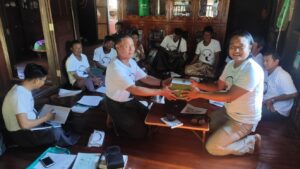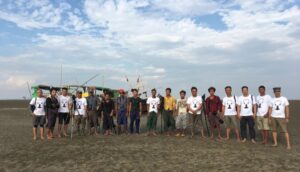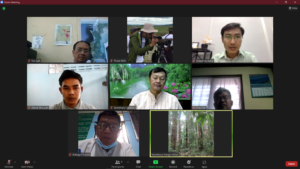EAAFP Small Grant Fund Project by
Pyae Phyo Aung, Shane Thu Lwin and Thura Soe Min Htike
Nature Conservation Society – Myanmar (NCS)

LCG members are looking the spotting the scope and binocular during the bird watching training © Nature Conservation Society – Myanmar
Participation of local communities in conservation is crucial for long-term conservation management. Two local Conservation Groups(LCGs) newly established in The Tanintharyi region are improved their conservation skills through five consecutive bird-watching training sessions. Two LCGs from the area of the Gulf of Mottama are also trained to elaborate their bird-watching, patrolling and conservation skills. Vinyl billboards were installed in the public areas of Myeik and Boke Pyin to raise the awareness of the conservation of migratory shorebirds during their wintering season. This year, 2021-2022 a total of nine national surveyors conducted an annual wintering census survey of Spoon-billed Sandpiper and migratory shorebirds at the Gulf of Mottama and Tanintharyi coastal accompanied by the LCGs members.
For the Gulf of Mottama Ramsar site, the survey team covered upper Gulf located in east coastal where recorded 17 and estimated 80 critically endangered Spoon-billed Sandpiper (SBS), based on the SBS proportion in 173 flock counts of over 34,914 birds extrapolated to an estimated 160,000 birds of small waders in the area. These birds were encountered by the team at low tide feeding and widespread across the vast mudflat habitats. Former hunters of the Local Conservation Groups (LCGs) joined the survey and guided the survey team onto the small wader flocks. They were trained and informed about the survey techniques, biology and significance of the species in a regional, national and global context.

Providing binoculars to LCG team © Nature Conservation Society – Myanmar

Survey team members with LCG at the Gulf of Mottama © Nature Conservation Society – Myanmar
Three sites located at the North of Myeik mudflat, recorded ten globally threatened species such as Nordmann’s Green Shank, Great Knot, Chinese Egret, Black-headed Ibis, Bar-tailed Godwit, Black-tailed Godwit, Eurasian Curlew, Curlew Sandpiper, Red-necked/Little Stint and Red-breasted Parakeet.
Three sites located at the Bokepyin mudflat, recorded twelve globally threatened species such as single Spoon-billed Sandpiper, Black-tailed Godwit, Bar-tailed Godwit, Eurasian Curlew, Nordmann’s Greenshank. During the project implementation period, NCS keep communicating with the existing LCG members in the Gulf of Mottama for the conservation actions and formation the new LCG team at Tanintharyi coastal region. Tanintharyi costal region is also important for migratory water birds and needs to be conserved as a legal flyway network site or Ramsar Site. Moreover, the NCS team is coordinating with Tanintharyi region Forest Department for the Spoon-billed Sandpiper conservation activities and introducing Tanintharyi coastal as a new flyway network site.

Discussion between NCS and Officers from Forest Department for shorebird conservation, Tanintharyi Region via Zoom on 30 November 2021© Nature Conservation Society – Myanmar
The project was funded through the 2021 EAAFP WG/TF Small Grant Fund. View the report, Click here.





